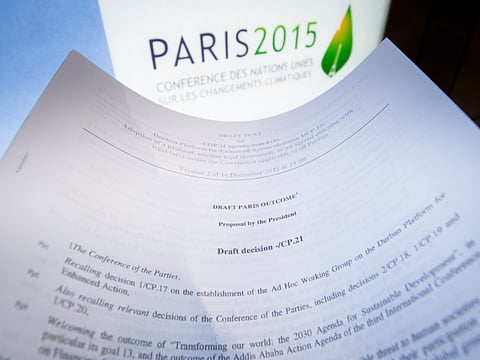Climate pledges: Who promised what?
Among the top 10 greenhouse gas emitters, here’s who has promised what

LE BOURGET, France: Some 185 countries submitted pledges to reduce greenhouse gas emissions ahead of UN climate talks aiming to close Friday with a historic climate deal.
They account for the vast majority of the world population and are responsible for roughly 95 per cent of emissions driving dangerous levels of climate change.
The voluntary pledges - dubbed Intended Nationally Determined Contributions or INDCs - will help cap global warming at two degrees Celsius (3.6 degrees Fahrenheit) over pre-Industrial Revolution levels, the UN-endorsed goal. They begin in 2020, with a few running to 2025 and the rest to the end of the decade.
But they are inadequate to meet the 2C target, and place the world on track for warming closer to 3C, several analyses conclude.
Among the top 10 emitters, here’s who has promised what:
1) China - 24 per cent of global greenhouse gas emissions
China envisages a peak in emissions “by around” 2030, and reducing carbon intensity (CO2 emitted per unit of gross domestic product) by 60-65 per cent by 2030 compared with 2005 levels.
The world’s most populous nation will boost the share of non-fossil fuel in primary energy consumption from 11.2 per cent in 2014 to 20 per cent, and boost the volume of CO2-absorbing forest by about 4.5 billion cubic metres (159 billion cubic feet).
2) United States - 15.5 per cent
The United States has pledged a 26-28 per cent reduction in emissions from 2005 levels by 2025. Power plants are to cut carbon dioxide pollution by 32 per cent from 2005 levels by 2030.
3) European Union - 10.8 per cent
The 28-member European Union intends to cut emissions by at least 40 per cent by 2030 over 1990 levels, and has set 27 per cent targets for renewable energy supply and efficiency gains.
4) India - 6.4 percent
India plans to reduce carbon intensity by 35 per cent by 2030 from 2005 levels, and to generate 40 per cent of its electricity from renewable sources by the same date.
5) Russia - 4.9 per cent
Russia has proposed cutting emissions by 25-30 percent by 2030 from 1990 levels, conditional on the pledges of other “major emitters”.
6) Japan - 2.9 per cent
Japan has pledged a 26 percent reduction in emissions from 2013 levels by 2030, with nuclear energy - offline since the 2011 Fukushima disaster - providing 20-22 per cent of electricity by then.
Renewable electricity production, including hydro power, would be expanded to a 22-24 percent share, from 11 percent in 2014.
7) Brazil - 2.1 per cent
Brazil will cut emissions 37 per cent by 2025 from 2005, and 43 per cent by 2030.
8) Iran - 1.6 per cent
Iran has made an unconditional pledge to reduce its greenhouse gas emissions in 2030 by four per cent compared with a “business as usual” scenario.
In addition, Tehran said it would reduce emissions another eight per cent if it receives financial and technology support, and if what it describes as “unjust sanctions” were lifted.
9) Indonesia - 1.6 per cent
Indonesia envisages a 29 per cent cut in emissions by 2030 compared with what the level would have been without any action. With financial and other help, this could be raised to 41 per cent.
10) Canada - 1.5 per cent
Canada will seek to cut emissions by 30 per cent from 2005 levels by 2030.
Sources: UN Framework Convention on Climate Change (UNFCCC), Climate Action Tracker, Climate Analytics.
Sign up for the Daily Briefing
Get the latest news and updates straight to your inbox



